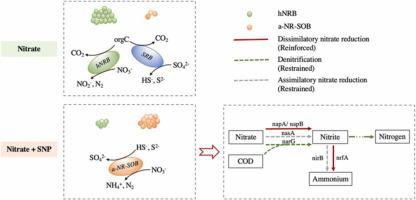Journal of Hazardous Materials ( IF 12.2 ) Pub Date : 2021-10-16 , DOI: 10.1016/j.jhazmat.2021.127527 Guijiao Zhang 1 , Zhi Yang 2 , Yongchao Zhou 3 , David Z Zhu 2 , Yiping Zhang 3 , Tong Yu 2 , Adam Shypanski 4

|
Nitrate has been widely used in sewer systems for sulfide control. However, significant chemical consumption and the loss of carbon source were observed in previous studies. To find a feasible and cost-effective control strategy of the sulfide control, the effect of nitrate combined with sodium nitroprusside (SNP) dosage strategy was tested in lab-scale sewer biofilm reactors. Results showed that nitrate and SNP were strongly synergistic, with 30 mg N/L nitrate and 20 mg/L SNP being sufficient for sulfide control in this study. While large amount of nitrate alone (100 mg N/L) is required to achieve the same sulfide control effectiveness. Meanwhile, the nitrate combined with SNP could reduce the organic carbon source loss by 80%. Additionally, the high-throughput sequencing results showed that the relative abundance of autotrophic, nitrate reducing-sulfide oxidizing bacteria genera (a-NR-SOB) such as Arcobacter and Sulfurimonas was increased by around 18%, while the heterotrophic, nitrate-reducing bacteria (hNRB) such as Thauera was substantially reduced. It demonstrated that the sulfide control was mainly due to the a-NR-SOB activity under the nitrate and SNP dosing strategy. The microbial functional prediction further revealed that nitrate and SNP promoted the dissimilatory nitrate reduction process which utilizes sulfide as an effective electron donor. Moreover, economic assessment indicated that using the combination of nitrate and SNP for sulfide control in sewers would lower the chemical costs by approximately 35% compared with only nitrate addition.
中文翻译:

硝酸盐和硝普钠联合投加用于控制下水道生物膜反应器中低碳源损失的硫化物
硝酸盐已广泛用于下水道系统中的硫化物控制。然而,在先前的研究中观察到显着的化学品消耗和碳源的损失。为了找到一种可行且具有成本效益的硫化物控制策略,在实验室规模的下水道生物膜反应器中测试了硝酸盐结合硝普钠 (SNP) 剂量策略的效果。结果表明,硝酸盐和 SNP 具有很强的协同作用,本研究中 30 mg N/L 硝酸盐和 20 mg/L SNP 足以控制硫化物。而仅大量硝酸盐(100 mg N/L) 需要达到相同的硫化物控制效果。同时,硝酸盐与SNP结合可以减少80%的有机碳源损失。此外,高通量测序结果表明,自养、硝酸盐还原-硫化物氧化菌属 (a-NR-SOB) 如弓形杆菌和硫化单胞菌属的相对丰度增加了约 18%,而异养、硝酸盐还原菌属的相对丰度增加了 18%。 (hNRB) 例如Thauera大幅减少。这表明硫化物控制主要是由于硝酸盐和 SNP 给药策略下的 a-NR-SOB 活性。微生物功能预测进一步揭示了硝酸盐和SNP促进了利用硫化物作为有效电子供体的异化硝酸盐还原过程。此外,经济评估表明,与仅添加硝酸盐相比,将硝酸盐和 SNP 组合用于控制下水道中的硫化物可将化学品成本降低约 35%。











































 京公网安备 11010802027423号
京公网安备 11010802027423号